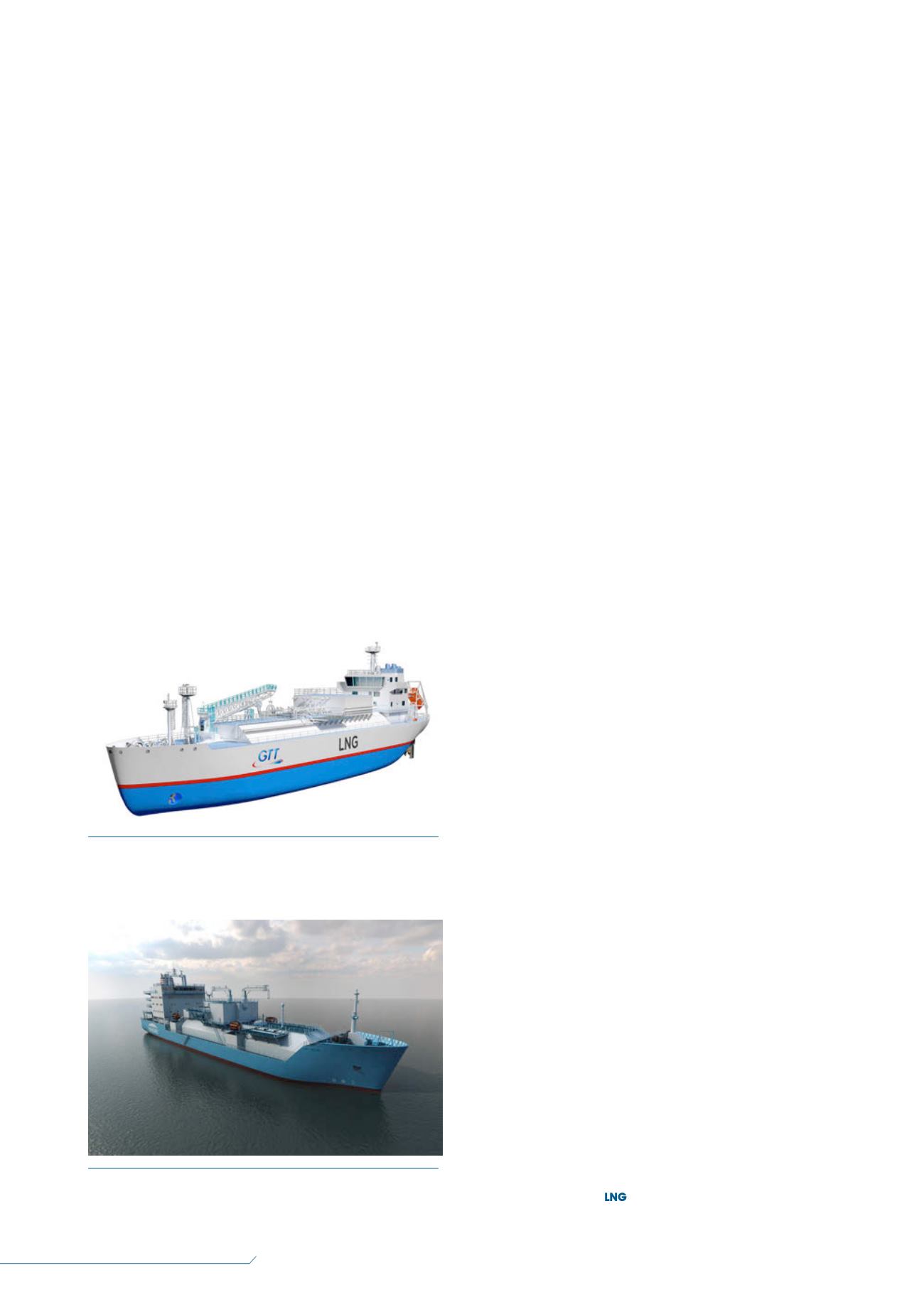
60
LNG
INDUSTRY
APRIL
2016
bunker its two new LNG-fuelled car carriers, which will
operate in European waters. When not delivering to UECC,
the new bunker vessel will provide an LNG fuel delivery
capacity around the North European waters.
The role of Zeebrugge port, Belgium, has been important
in facilitating this first step. It has conducted deep safety
studies with BV’s consulting arm, Tecnitas, before granting
authorisation for loading the LNG at the Fluxys terminal in
Zeebrugge.
Further north, Norway’s Skangas has an established
client base of LNG-fuelled passenger ferries and tankers. It
plans to operate a 100 m long bunker vessel, which will carry
5800 m
3
of LNG at 4.5 bar in two bi-lobe tanks. The vessel,
which will be named
Coralius
, will be built to BV class at
Royal Bodewes in the Netherlands for Sirius Veder BV. It will
sail under the Swedish flag and its 3000 kW dual-fuel
engines and extensive thruster outfit will give it the speed
and manoeuvrability to deliver gas around a wide area of the
Norwegian, Swedish and Danish coastline. Four 250 m
3
/hr
pumps will deliver a high bunker rate to receiving vessels.
A shift to membrane?
Bunker tankers to date use Type C tanks, but a move to
membrane tanks may offer more flexibility. BV has granted
Approval in Principle (AIP) to a 4000 m
3
bunkering ship
concept developed by Gaztransport & Technigaz (GTT).
The concept is for a bunker tanker that could deliver LNG
as marine fuel using tanks with a GTT Mark III Flex Cargo
Containment system operating up to a pressure of 2 barg.
Combining the membrane containment system with the
ability to store LNG at pressures up to 2 barg would allow
the bunker vessel to have a higher capacity and increased
operational flexibility.
This pressurised membrane tank concept means LNG
bunker tankers can manage BOG better and increase loading
and delivery flowrates.
Under GTT’s system, the BOG management during
loading and bunkering operations is made more flexible
because of the wide vapour pressure operating range.
Vapour can be buffered and condensed in the tanks to help
the receiving vessel or feeding facility handle the vapour.
Condensation may be performed by spraying LNG into the
vapour phase. The higher pressure also means that during
voyage and standby mode, the duration before gas pressure
in the bunker tanker’s tanks reaches the upper limit is longer.
This improves the holding time when BOG is not being
consumed and reduces the use of a reliquefaction plant,
reducing costs.
Quality and quantity
There are established and simple methods of measuring
bunker quantities and qualities for oil, but currently there is
no commercial consensus around a similar global standard
for LNG as fuel. LNG has to be measured in terms of energy
delivered, and the chief engineer on the receiving vessel
cannot simply sound his tanks and send a sample bottle
off to a laboratory for fuel analysis. Classification societies
and the LNG industry need to work together to develop an
accepted and standardised means of determining energy
content, which is a function of volume x gross heating
value x density.
Presently, the determination of the net volume
transferred in cubic metres is measured by gauging the level
of LNG in the tanks of the bunkering vessel before and after
bunkering operation, with a radar and/or float level gauge
and correcting for trim and list using tables. LNG and vapour
temperature and pressure are measured before and after the
transfer. A gas chromatograph on board the bunkering vessel
connected to a small vaporiser provides the composition of
LNG delivered and, from all this, the gross heating value
(kWh/kg) can be determined. The LNG density (kg/m
3
) is
calculated based on its composition at approximately -160°C,
according to the revised Klosek MacKinley calculation
method.
However, manufacturers of gas engines use the
so-called methane number (MN) for specification of gas
quality requirements. There is not yet a standardised method
for determining it. In the future, the question will arise
whether MN or density, a universal and measurable physical
quantity, is the most relevant criteria for LNG bunker
specifications. It is important to address commercial
confidence in the fact that, at present, measurement
depends on the bunker supply vessel.
LNG bunkering is an exciting part of the industry to be in
right now, with technical issues, commercial challenges and
fluid standards. BV is working in the right direction towards a
stable and mature LNG bunker chain. Once this is
established, the market will find LNG-ready ships queuing
up for the clean fuel.
Figure 3.
Gaztransport & Technigaz (GTT) 2 barg pressurised
bunker tanker concept.
Figure 4.
The first LNG bunker vessel for a Sulfur Emission
Control Area (SECA), to be built for an ENGIE-led joint venture.


